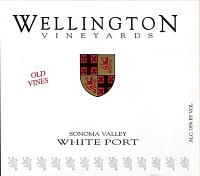 |
|
Wine Details
Price:
$24.00 per bottle
Description:
Our current bottling of white port is a blend of several vintages and grape varieties. The principal varieties in the white port are Chardonnay, Semillon, Burger, Palomino, Sauvignon vert and with small bits of Trousseau gris, Sylvaner, Riesling and Chasselas. All but the Chardonnay are from our 70 to 100 year old estate blocks. The current bottling is a blend that dates back over the past seven years and is offering more of the sherry qualities. The white port is lower in alcohol, acid and residual sweetness than the red port. As a result, it is softer and smoother, and a pleasant counterpoint to spice cookies, gingerbread and other lighter desserts.145 cases produced.
|
|
Varietal Definition
Chardonnay:
Chardonnay is by far the most widely planted grape crop in California and dominates California’s cooler, coastal, quality wine regions. The natural varietal ‘taste and smell’ of Chardonnay is surprisingly unfamiliar to many wine drinkers, as its true character is often guised with dominating winemaking signatures. Chardonnay’s rather subdued primary fruit characteristics lean toward the crisp fruitiness of apples, pears and lemon, but the variety’s full body is capable of supporting a host of complementary characteristics, such as oak, butter and vanilla. Regardless of what is the appropriate style for Chardonnay, the varietal continues to dominate vineyard plantings in every corner of the world. Close attention to clonal selection has made this broad geographic and climactic range of Chardonnay viable in thoughtful viticultural hands.
|
Chasselas:
Minor grape grown in Switzerland, France and New Zealand. Widely grown in the cantons of the first country where it has several regional names, such as Perlan in the Mandement district. Mostly vinified to be a full, dry and fruity white wine. In France it is mostly grown in the Loire region where it is converted into a blend with Sauvignon Blanc called "Pouilly-sur-Loire" and in the Savoy region where it is treated in the Swiss manner. In New Zealand it is mainly made into popular sweet white wines.
|
Riesling:
On the sweeter end of the spectrum, some of the best dessert wines should give thanks to the Riesling varietal. Riesling is known for its complementary nature of combining balanced acidity with sugar. Rieslings are made dry to sweet, but it is the sweet style Riesling that brought about its popularity in the United States. With the rise of spicy sauces, marinades and dips to flavor our meal, Riesling plays a part in taking off the edge of the heat. Riesling is known for a number of signature characteristics: floral, citrus and pear. Riesling has peaked in California with 11,000 acres planted. Today, Monterey County’s cool-climate areas and its long growing season produce good amounts of character for the Riesling grape. Outside of
|
Sauvignon Vert:
Alternative name for the Tocai Friulano grape of northern Italy. In California the grape known as Sauvignon Vert is probably a Muscadelle varietal clone.
|
Sylvaner:
Widely grown in the Alsace region of France, Germany and Central Europe. Suited to temperate zones, the vine is high-yielding and the grape produces an "easy" white wine with lightly spicy, floral flavors and mild intensity. Once very popular in California, it seems to have fallen victim to changing fashion in recent years and been replaced by Johannisberg Riesling in current taste. It has also been crossed with the latter grape to yield the Muller-Thurgau hybrid grape and another hybrid version called Scheurebe as well as several other crossings of a similar nature.
|
Trousseau Gris:
Mutated version of the Trousseau grape found in the Jura region of France. Thought to be the grape misleadingly known as the Grey Riesling in California although it has no relationship with the Riesling cepage. Something of a mystery grape, it may also be the variety known as Bastardo in Portugal and Cabernet Gros in Australia.
|
Palomino:
Palomino is a white grape widely grown in Spain and South Africa, and best known for its use in the manufacture of sherry. Also found in Australia and California where it is also used mainly to produce fortified wines, the grape was once thought to be the Golden Chasselas, a grape grown in California. The wine-must has tendency to oxidise quickly, a characteristic that can be ignored when used for sherry production. In Spain, the grape is split into the sub-varieties Palomino Fino, Palomino Basto, and Palomino de Jerez, of which Palomino Fino is by far the most important, being the principal grape used in the manufacture of sherry. The wine formed by fermentation of the grape is low in both acidity and sugar which, whilst suitable for sherry, ensures that any table wine made from it is of a consistently low quality, unless aided by acidification. In France, it is referred to as Listán, and in South Africa as Fransdruif or White French.
|
|